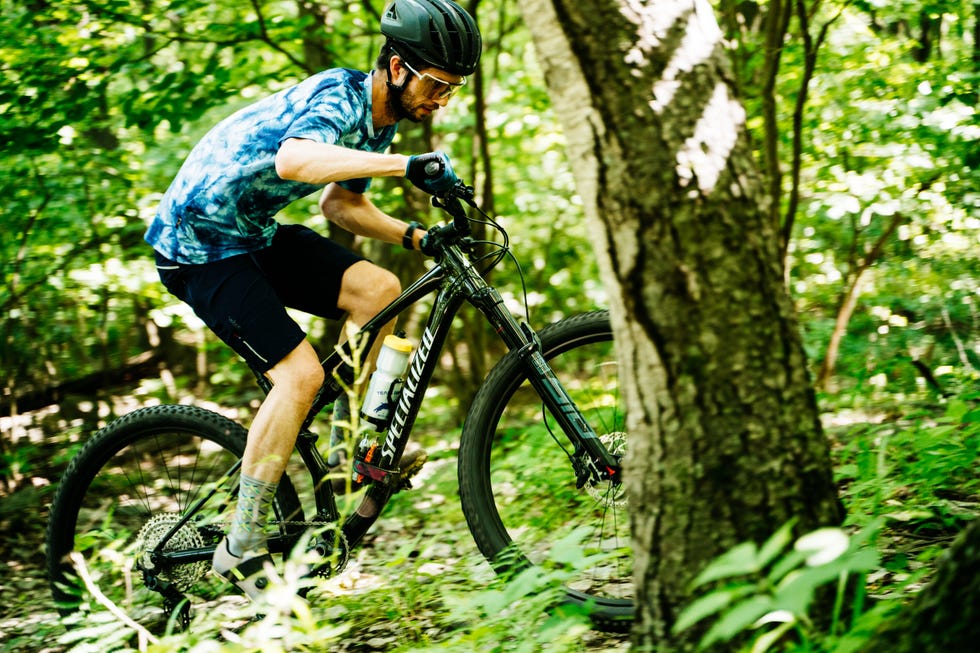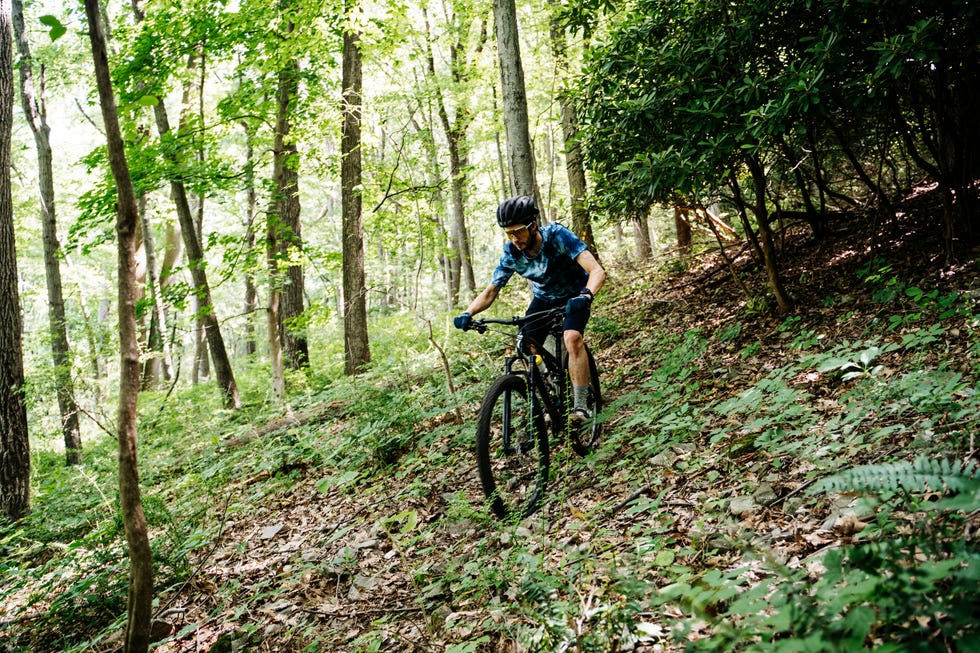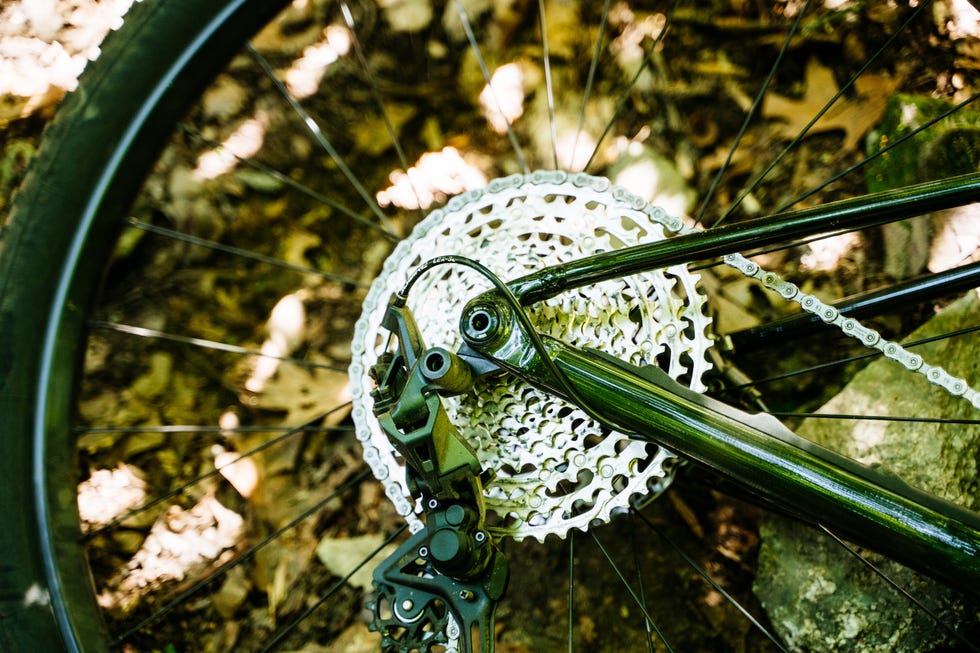
Trevor Raab
To be perfectly fair to the Chisel, I did not expect a 13-kg bike to ride the same way a 10-kg bicycle does. The lack of those three kilos gives bikes like the Epic 8 their lethal efficiency on climbs. But after riding the Chisel, it is clear that Specialized used the right geometry, suspension kinematics, and amount of travel to capture the essence of what makes modern XC bikes so good and so versatile.

Trevor Raab
Climbing on the Chisel is certainly the bike’s weak point, but truth be told, you don’t feel it all that much on the trail. Particularly when climbing seated up a rough bit of singletrack, the rear of the bike feels perfectly planted on the trail. A stiff frame with lots of rear wheel traction makes the Chisel feel much lighter and snappier than its weight might initially suggest. Climbing on smoother trails or fire roads is where I would expect to feel the bike’s weight the most, but even there, I was left thoroughly impressed and delighted by the Chisel’s pep.

Trevor Raab
Point the Chisel back downhill, and you’re instantly rewarded. It’s a bike that feels incredibly poppy, easy to flick in and out of corners, and it’s a total hoot to bump-jump off small lips, rocks, and roots. The stiff aluminium frame shines with how accurate it feels when pinging your way through a rock garden or down a succession of small drops.
Modern mountain bike geometry makes shorter travel bikes much more capable than before. So, if you want to chase an enduro bud down a rowdy downhill, the Chisel will keep up, providing you have the skill (and guts) to do it. In its stock form, you’re more likely to run out of brakes and tyres before reaching the limit of the suspension and geometry.
Though it does its job admirably well, the Chisel only has 120mm (front) and 110mm (rear) wheel travel. The bike has impressive traction, and while I never felt like I was blowing through the travel, it’s still fundamentally a cross-country bike with a single pivot/flex stay rear suspension layout. This system trades weight for the small bump sensitivity and refinement you can get from heavier and more complicated rear suspension designs. This means the Chisel feels harsh on particularly chunky trails, where you constantly hit rocks and roots.

Trevor Raab
In its stock form, the Chisel is a great bike but brands always make some compromises on bikes in this price range to hit the cost target. If there’s a single part holding the Chisel back, it’s the stock wheels. The 27mm internal width is reasonable but still felt narrow. When absorbing an impact through a corner, there was quite a bit of tyre squirm, which can be unsettling if you’re not used to it.

Trevor Raab
A highlight of the Chisel build kit for me was the Shimano drivetrain parts. The SLX parts on the Chisel performed flawlessly. The shifting is precise and has wonderful tactile feedback. I did not feel that changing gears using a cable held the bike (or me) back one bit.
Is the Chisel Worth It?
The value proposition of a bike is always a tricky subject because it is highly subjective. For some riders, a R59k or a R49k bike is cheap. For others, it could be the most money they ever spend on a bike.
What struck me the most was how absent aluminium full-suspension cross-country(-ish) bikes are from the lineups of other large brands. Cannondale, Giant, and Canyon do not offer aluminium variants of the Scalpel, Anthem, or Lux.

Trevor Raab
But for all these bikes, the closer they get to R70,000 in price, the more the aluminium bikes start to overlap with lower-end carbon models. This is especially true if riders look past current-year models and consider bikes from a previous model year that are often on sale.
This is likely the main reason higher-end aluminium bikes have largely disappeared from the mid-tier of many brand lineups. Consumers overwhelmingly prefer and buy carbon fibre bikes. They would rather look for a carbon bike to fit their budget than consider an aluminium alternative. But in this price range, the aluminium models often feature better parts and are not much heavier.

Trevor Raab
Plus, there are some genuinely good reasons to consider an aluminium bike besides price. For one, aluminium makes for a durable frame that can brush off scrapes, rock strikes, and small impacts that might necessitate a more thorough damage inspection on a carbon frame. It’s also worth considering that aluminium bikes are significantly less energy-intensive to produce. Plus, aluminium is an easier material to recycle. Sure, those last two reasons might not enhance the bike’s performance, but they’re a nice bonus. Still, if you are a rider who’s tough on frames, the durability aspect of going aluminium is hard to overstate.
Final Thoughts
While it’s unlikely that most riders will view aluminium frames as having the same cache as carbon fibre, plenty of folks appreciate what aluminium offers. The cult status of road bikes like the Specialized Allez Sprint and Cannondale’s long-running CAAD series certainly come to mind in this context. The original Chisel hardtail showed glimmers of a similar following, but for the most part, aluminium mountain bikes have yet to gain equal fandom.
Is the new Chisel good enough to change that? I certainly think so.

Trevor Raab
I don’t think the Chisel will tempt many riders with bigger budgets to overlook carbon models in its favour. But riders who opt for the Chisel are not “settling” for aluminium by any stretch of the imagination. Riding the Chisel made me just as giddy and happy as riding mountain bikes that cost five times as much. So while there’s nothing wrong with aspiring to a carbon bike, the aluminium Chisel has no real downside.


















